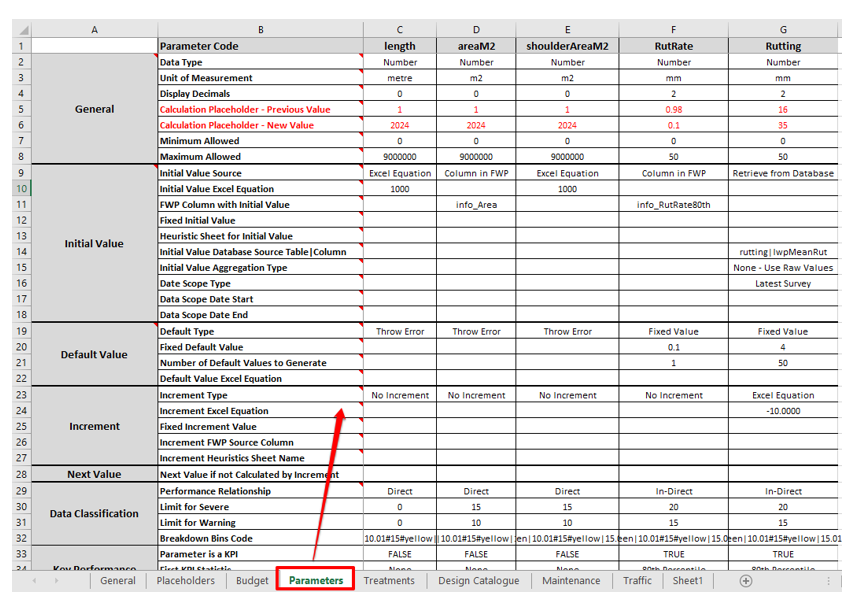Help posts addressing each section of the DMS File
DMS File - Parameters: Overview
|
Philip van der Wel Administrator Posts: 145
1/19/2017
|
Philip van der WelAdministrator Posts: 145
The Parameters sheet in the Deterioration Model Setup (DMS) file plays a central role in the model, containing the definitions for all parameters which will be modeled forward through the modelling period.

The image above shows an example of how the model parameters are defined in the DMS file. From the image, without going into specific details, the following should be noted:- Each model parameter is specified in a different column, starting from column C and moving to the right. To add a new model parameter, simply copy and paste one of the existing parameter columns and edit as required.
- Parameter properties (e.g. “General”, “Initial Value”, “Increment”) define different aspects of the parameters.
- For each property, there is a set of inputs that need to be completed for each parameter. These inputs may include the Excel equations to use, for example, when calculating increment values.
JunoViewer web allows you to define any number of model parameters, however, the following three parameters are mandatory and must be listed at the left of the parameter columns in the following order:
- length: Used to specify segment length which is needed to calculate treatment costs that use a metre length unit rate
- areaM2: Used to specify the area which is needed to calculate treatment costs that use a square metre unit rate
- shoulderAreaM2: Used to specify the shoulder area which is needed to calculate shoulder treatment cost that use a square metre unit rate
The following properties are required to be completed in the Parameters sheet; follow the hyperlinks to view a separate help post for each:
General
General inputs relate to the name, type, and allowed ranges for each parameter.
Initial Values
Initial Value inputs specify how and where the model should retrieve the initial (i.e. starting) values for the model parameter.
Default Values
Default Value inputs tell the model what to do when no initial value can be found. This is quite important, since the model cannot run unless each parameter has a valid starting value for each model segment.
Increment
Increment inputs specify how each model parameter should be incremented from one modelling year to the next. Essentially, the input determines how fast the modelling segment will deteriorate on each segment of the network.
Data Classification
Data Classification inputs tell the model how to group data for each parameter in terms of performance bins. This grouping has an impact on colour coding and in a number of reports within Forecast View..
Key Performance Indicators (KPI)
KPI inputs determine if a parameter is a KPI, and the statistics to use for reporting in the Forecast View and Model Output Report.
Report – Increment Graph
Increment Graph inputs tell the model how to format the increment graph in the report for a parameter.
Report – Breakdown Graph
Breakdown Graph inputs tell the model how to format the breakdown graph in the report for a parameter.
Report – Data Export
Data Export inputs define whether a detailed export of data in the report is required for a parameter and which statistic should be used.
Report – High-Low Graph
High-Low Graph inputs tell the model how to format the high-low graph in the Forecast View.
edited by philip on 1/20/2017
|
|
|
0
link
|
